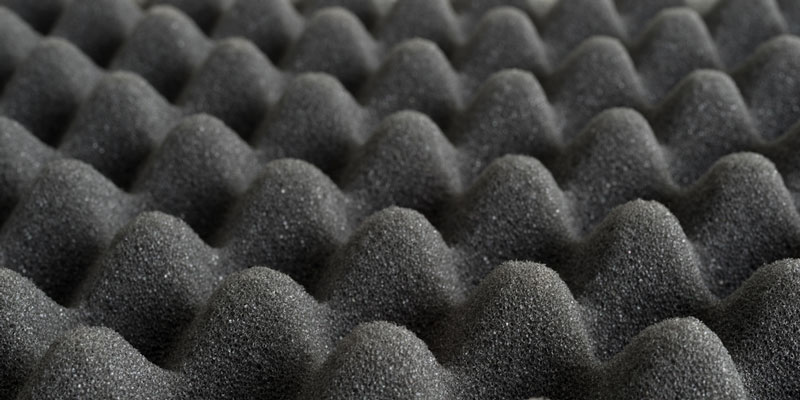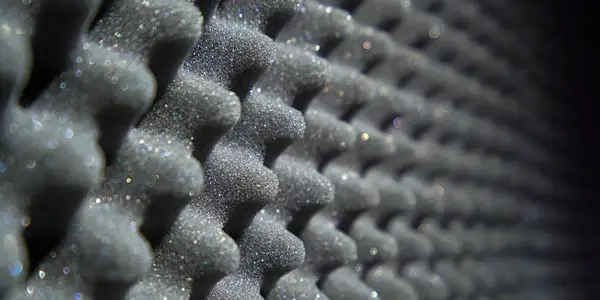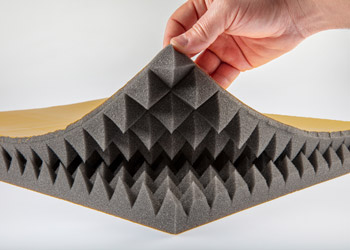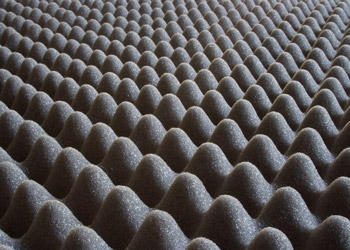Soundproofing your space guarantees better sleep quality and increased work efficiency, especially if you live or work in a noisy environment. However, soundproofing can be expensive, which leads us to some creative ideas for damping the noise.

There are many affordable ways to achieve a quiet space, and one of the options people consider is an egg crate. But does egg crate foam work for soundproofing? Can egg crate foam completely soundproof a space?
The simple answer is no, and you are not wrong to doubt the efficiency of this material in reducing high-frequency sound waves and noise. Hence, in this post, we’ll uncover the truth about egg crate foam as a soundproof material and provide other budget-friendly alternatives.
Soundproofing With Egg Crate Foam
If you are not looking to break the bank soundproofing your room, egg cartons might seem the way to go. After all, you already own a lot of these styrofoam cartons or cardboard.
This readily available cheap material is often used for soundproofing a small to medium-sized space, which seems like a reasonable thing to do.
So, Does Egg-Crate Foam Work for Soundproofing?
Theoretically, Egg cartons have sound-blocking properties to prevent noise from traveling through the walls. Egg crates are made of cardboard or styrofoam, making them an affordable option for people looking to soundproof their room under a tight budget. So, on paper, this material should help diffuse sound waves, thanks to their paper construction and shape.

However, this material does not block or absorb noise very effectively, rather spreads the sound out and changes the direction and magnitude of its movement.
Using egg crates for soundproofing is a misconception that started because of the appearance and shape of egg cartons. This material looks similar to the acoustic foam used in recording studios. Hence, people assumed that their saved egg cartoon could substitute the acoustical soundproofing foam.
While they share the same appearance, they are not designed for the same purpose. Acoustic foam is an engineer to help tackle echo and sound distortion in a room. It was never designed for blocking noise out of a room but for audio management.
On the other hand, egg crates are made to hold and transport your eggs by providing a cushion and reducing vibration. Hypothetically, suppose egg crates are a perfect substitute for acoustic foam. In that case, egg cartons should only be used to reduce sound resonance and echos at certain frequencies for better audio control.
In short, egg crates are not a smart idea for soundproofing. While it might help reduce echo, it won’t do much in keeping the noise out or in the confines of your room.
What Can Egg Cartons Do?
As said earlier, egg crates are not the best option for soundproofing. However, they can come in handy for audio management. Egg cartons can help manage echoes and sound distortion. Also, fiber cardboard might help deaden some sound frequencies when you place them over your wall.
This material is made up of fibers, which allow it to absorb some frequencies. However, it’s too thin to make a significant difference. Therefore, you might want to use more than one layer of cardboard on your walls. Plus, it saves you from the hurdles of saving up egg crates for months.
Egg cartons are perfect for protecting your eggs and can likely serve in audio control. For soundproofing, it’s best to stay away from egg cartons. Besides, you will have to collect many egg crates to get any significant results. It’s best to use other kinds of cardboard or foam; they are much easier and cheaper to get your hands on.
Can Egg Crates Be Made To Work Better?
Soundproof works best with mass. Materials with high mass reduce the noise and other vibrations. In this sense, egg crates are thin, which explains their inability to provide any sound-blocking function.
So, people tend to use more layers of cartons to make egg crate foam work for soundproofing. Nonetheless, it’s a low-mass, porous material that won’t absorb or stop sound. Using this material is a bad idea, no matter how many cartons to plan to stack to improve its efficiency.
Acoustic Foam vs. Egg Cartons Foam


Material
Egg crates are made with different materials, from plastic to recycled paper and foam. None of these materials are ideal for effective soundproofing.
On the other hand, acoustic foams are made of dense, open-cell polyurethane foam, which reduces the noise and other vibrations traveling through them.
Thickness
Acoustic foams are about 2 – 3 thick. They are way thicker than readily available egg crates, making them a better option for audio control and soundproofing. They offer better acoustic management when fixed on any surface.
Softness
Acoustic foams are softer, making sound waves less likely to bounce over them than egg crates. The latter tends to diffuse sound in different directions when noise and other vibrations hit its surface.
Density
Getting a better soundproofing result depends on the density of the material. Acoustic foams are heavier, which provides much-needed resistance to sound transmission. On the flip, egg crate foams are thin and allow noise and other vibrations to migrate in or out of them effortlessly.
Eggs Cartons & Its Risk
Apart from their poor soundproofing property, there are other reasons you might not want to opt for an egg crate to reduce echo or sound distortion in your room.
To start with, hanging egg crates on your walls can look ugly unless you are some creative DIY person. They won’t look visually appealing in any way in your rooms.
Another downside of using egg crates is that they are very flammable, leading to fire accidents at the flick of a cigarette.
That’s not all: egg crates can be dirty or unhygienic. You don’t want to hang an unclean egg carton on the wall, especially if it’s a room with kids playing music. Kids tend to touch everything and eat with their hands.
More so, you might want to rethink using egg crate foam because they are cheap since they are not durable. You will go through the stress of creating a thick layer of egg crate which will likely look ugly, and have to fix the broken egg carton now and then.
What Are The Alternatives to Egg Crate Foam For Soundproofing
Soundproofing a room can cost more than a thousand dollars. So, it’s understandable to want to look for a cheap alternative.
Luckily, there are a couple of options that won’t require you to break the bank for decent acoustic management and soundproofing.
Sound Absorption Blankets
Sound absorption blankets are durable and will serve your purpose for a long time. This is a cheaper and more effective way of blocking out the migrating noise. Also, you don’t have to break bones installing these blankets, unlike individual acoustic panels.
Soundproof Curtains
If your window is the underlying culprit, you consider purchasing thick, soundproof curtains to stop the noise coming from your windows. They function as sound absorption blankets. This option absorbs the noise seeping through your window for better sleep quality or productivity.
Conclusion
Does egg crate foam work for soundproofing? No, it’s designed to protect your eggs and should stay that way. If you are looking for cheap ways for acoustic treatment and soundproofing, it’s best to opt for acoustic foam, soundproof curtains, or sound absorption blankets. Egg crates are flammable and can be ugly when placed on your room’s walls.
Related Post:
